The first "Stalinist strike." Part of 2. The liberation of Veliky Novgorod from the German invaders
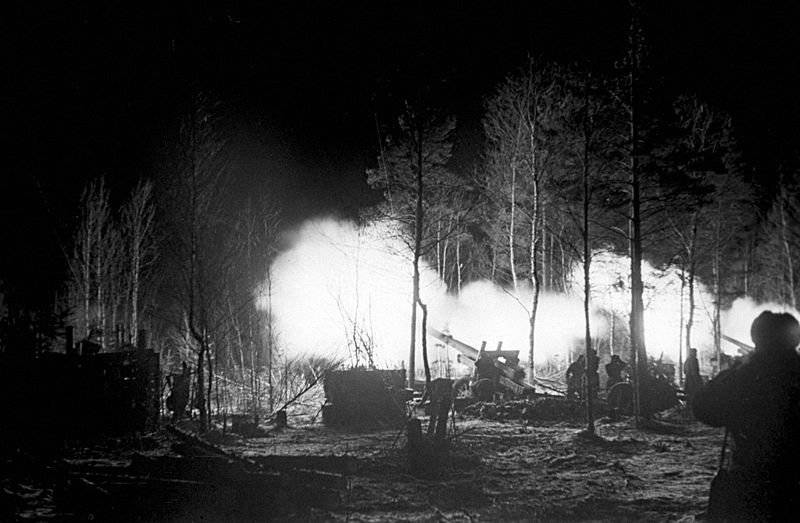
Veliky Novgorod was abandoned by Soviet troops 19 August 1941. Long and difficult was the path to the desired victory. The German occupation lasted 883 day. The most important part of the strategic Leningrad-Novgorod offensive operation was the Novgorod-Luga operation, which began on January 14. It was conducted by the Volkhov Front in full force and part of the forces of the Leningrad Front. 20 January 1944, the soldiers of the Red Army hoisted the red banner on the ancient Kremlin wall of Novgorod. In the Soviet capital in honor of the liberation of the ancient Russian city was given a salute.
Novgorod-Luga offensive operation (January 14 - February 15 1944 of the year)
January 14 The 1944 of the year simultaneously with the troops of the Leningrad Front launched the offensive of the 59 Army of the Volkhov Front. Thus began the Novgorod-Luga offensive operation. 59-I army under the command of Ivan Korovnikov received the task of defeating the German grouping in the area of Novgorod, to free Novgorod and the October Railway. The army struck a blow by the forces of the two groups in directions converging on Lyubyolady. The main forces attacked from the bridgehead on the left bank of the Volkhov in 30 kilometers north of Novgorod, auxiliary - in the area of Lake Ilmen, south of Novgorod. Later, after the liberation of Novgorod, it was planned to develop success in the western and south-western directions, to capture the city of Luga and cut off the ways of the withdrawal of the Nazis towards Pskov. The 8-I and 54-I armies of the Volkhov Front were to distract the enemy in the Tosno and Lyuban sectors, so that the Germans could not transfer them to the aid of the Novgorod grouping.
The Soviet troops were opposed by the 38-th, 26-th and 28-th army corps of the 18-German army (6 infantry divisions and 2 infantry brigades, 3 airfield divisions). The Germans relied on a network of strong resistance centers, among which Novgorod, Chudovo, Lyuban, Tosno, Mga and Luga were particularly notable. In the direction of the main attack of the Red Army, the Germans had two defensive lines: the main - along the Novgorod - Chudovo highway, the second - along the Kerest river. In addition, the city itself was defended by three defensive lines. In Novgorod itself, many stone buildings were turned into long-term firing points.
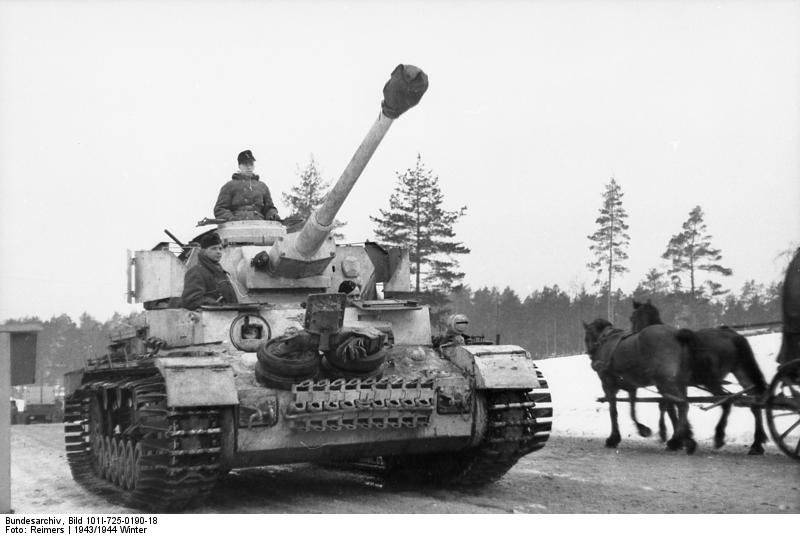
German tank PzKpfw IV moves to the position, Army Group North, February 1944
The Volkhov Front at the beginning of the operation numbered about 298 thousand people (according to other sources about 260 thousand people). The 59th Army, which played the main role in the offensive, numbered about 135 thousand people, the 8th Army - 45 thousand people, the 54th Army - 67 thousand people, the 14th Air Army - more than 16 thousand people, more than 33 thousand people were in the front-line subordination units. The WF had 3633 guns and mortars, about 400 tanks and self-propelled guns, 257 aircraft.
On the first day of the offensive, the 59th Korovnikov army did not achieve noticeable success. The Germans, relying on a powerful defense, fought desperately. In addition, snow and blizzard ruled out support aviation, and the help of artillery made ineffective. Armored vehicles were stopped by swamps. Soviet troops advanced only 600-1000 meters. The auxiliary, “southern group” of the 59th Army, under the command of Major General T. A. Sviklin, advanced more successfully. Soviet soldiers were able to cross the ice of Lake Ilmen at night and, with a sudden attack, captured a number of enemy strongholds and occupied a bridgehead.
The German command, fearing the encirclement of the Novgorod group, sent additional forces to the area (units of the 290 and 24 units of the infantry divisions, and the Nord cavalry regiment).
The commander of the 59 Army, in order to increase the force of the strikes, introduced additional forces from the second echelon in the northern and southern directions. As a result of the brutal 15-16 battles of January, the Red Army broke through the enemy’s main line of defense. Railway Novgorod - Chudovo was cut. In the following days, the troops of the 59 Army continued their slow advance. 18 January, the southern group cut the highway and the Novgorod-Shimsk railway. Parts of the northern group 20 January went to the railway Novgorod - Batetsky. The resistance of the German troops was strong, so the rate of advance was low - 5-6 km per day. It is also necessary to take into account the off-road and wooded-marshland factor. This did not allow in a short time to surround the Novgorod grouping of the enemy. The German command retained the ability to maneuver reserves and deploy troops from unattached sections of the front.
The German command, trying to rectify the situation, redeployed new troops - units of the 21, 121 of the infantry and 8 of the chasseurs divisions and some other units. However, the situation could not be saved. To avoid the encirclement of parts of the 38 Army Corps, the commander of the 18 Army, Lindeman, ordered to leave Novgorod. The Germans, abandoning heavy weapons, retreated in the direction of Batetsky. In the morning of January 20, Soviet troops occupied Novgorod without a fight.
The Novgorod grouping - the compounds of the 28 th jäger, 1 th airfield divisions and the SS "Nord" cavalry, could not leave. Two groups 59 th Soviet army had already joined. Reflecting all attempts to break out of the encirclement, as well as German attacks from outside the ring, part of Korovnikov’s army, together with the 7 rifle corps from the front reserve, destroyed the enemy’s disparate groups in the forests west of Novgorod. About 3 thousand Germans were captured.
January 16 The 1944 of the year launched an offensive on the wonder-Lyuban line of the 54 Army under the command of Sergei Roginsky. She fought part of the 26 and 28 of the German army corps. For several days there were fierce battles. Roginsky's army was able to advance only 5 km. The German command ordered to keep the Chudovo and Lyuban area at any cost, since important communications took place here - the October Railway and the Leningrad-Moscow highway. The Mginsk grouping was retreating to this area, and the Avtoban interim defense line was here.
January 21 The 8-I Army of the Volkhov Front liberated MGU. The retreat of the German troops from the Mginsky-Sinyavinskiy ledge forced the Soviet command to correct plans. The 67 Army of the Leningrad Front and the troops of the Volkhov Front were given the task of liberating the Oktyabrskaya Railway and Krasnogvardeisk. On January 22, the Military Council of the HF presented to BET the development plan for the operation. Parts of the 59 Army were to liberate Luga, and the troops of the 8 and 54 armies were to be in the Tosno and Lyuban area. The 54 th army strengthened at the expense of parts of the 8 th, 67 th armies and reserves of the front. Fierce fighting went on for several days. Only 26 of January Soviet troops took Tosno, January 28 liberated Lyuban and January 29 - Chudovo. From the enemy cleared the October Railway and the Leningrad highway.
By the end of January, the troops of the Volkhov Front, having overcome 60-100 km with heavy fighting, reached the Luga River. However, the German command was able to quickly strengthen its forces in the area of Luga and gain a foothold on the previously prepared line. The Germans moved the 12 Tank Division here.
On January 31, units of the 2 Shock Army of the Leningrad Front forced Luga and began storming Kingisepp. 1 February Kingisepp was released. Developing success, the army captured small bridgeheads on the left bank of the r. Narva. The 42 Army of the Leningrad Front reached the border of Luga by January 27. Having crossed the river, the army of February 1944 took Gdov and went out to Lake Peipsi.
The main task of the Volkhov Front still remained the liberation of the city of Luga. 59-I and 8-I armies attacked the city from the east, and 54-I army from the northeast. The Soviet offensive on Luga developed slowly. The German command collected all the available forces and reserves of the 18 and 16 army in the area of Pskov and Luga. The commander of the Army Group North, Walter Model, gave the order to keep the area at all costs. The model was appointed commander of Army Group North, 31, in January, replacing Georg von Kühler, who began a general retreat, despite the direct ban of Adolf Hitler. As a result, the Soviet troops were able to liberate Luga only February 12.
Due to the fact that the troops of the Volkhov Front could not solve the task of mastering the enemy’s Luga knot, the front was disbanded. February 13 1944 The headquarters transferred the 54, 59 and 8 armies to the Leningrad Front, the 1 shock troops (February from 2 to 15 as part of the WF) to the 2 Baltic Front. The front control was transferred to the reserve Supreme Command Stakes.
Thus, during the Novgorod-Luga opeartion, the Soviet troops won a victory, which to a large extent predetermined the success of the entire Leningrad-Novgorod strategic offensive operation (the first “Stalinist strike”). By February 15, the troops of the Volkhov Front, and the LF army, drove the enemy back to 50-120 km and reached the southern coast of Lake Peipsi. 779 cities and towns were liberated, including Novgorod and Luga. Of great importance was the release of such strategic communications as the October Railway and the Leningrad Highway.
German troops could not cling to the Luga line, establishing a new front line between the Ilmensky and Peipsi lakes. The German command had to withdraw troops to the line of defense "Panther".
But the advance of the Red Army did not develop as rapidly as originally planned. To seize Luga in a short time and only by the forces of the WF failed. To accomplish this task, the forces of the 42 and 67 armies of the Leningrad front had to be attracted. This weakened the onslaught of the Leningrad front in the Narva region. Therefore, even though the German 18 Army was defeated, it was not completely defeated and retained its combat capability. As a result, this did not allow the Soviet armies to crush the main forces of Army Group North by the spring of 1944, break through the Panther line and proceed to the liberation of Estonia and Latvia.
Destruction of Novgorod
During the occupation, the Nazis almost completely destroyed the city. Of the 2346 dwellings available before the war in Novgorod, only 40 remained. Almost all industrial enterprises, including a foundry, a mechanical, a ship repair, two brick plants: a tile and a sawmill, were destroyed. A shipyard, railway depot, meat processing plant, bread factory, shoe and furniture factories were also destroyed. The Nazis destroyed the city infrastructure: water supply, water and pump stations, telephone exchange, post office, telegraph, radio center and electrical facilities. The Germans struck at scientific, educational and cultural institutions. Before the war, Veliky Novgorod was a major Soviet scientific and cultural center. The Nazis destroyed the museum building and its art gallery; robbed a scientific library, a photo library containing the rarest data and a bibliographic file of the Institute stories Academy of Sciences of the USSR; pedagogical institute, technical schools, pedagogical school, medical schools, 3 hospitals, maternity hospital, children's clinic, main building of the psychiatric hospital, Red Army House, city theater, 2 cinema, 5 clubs, etc., were burned. According to the Emergency Commission on the atrocities of the fascist invaders, material damage to the city amounted to more than 11 billion rubles.
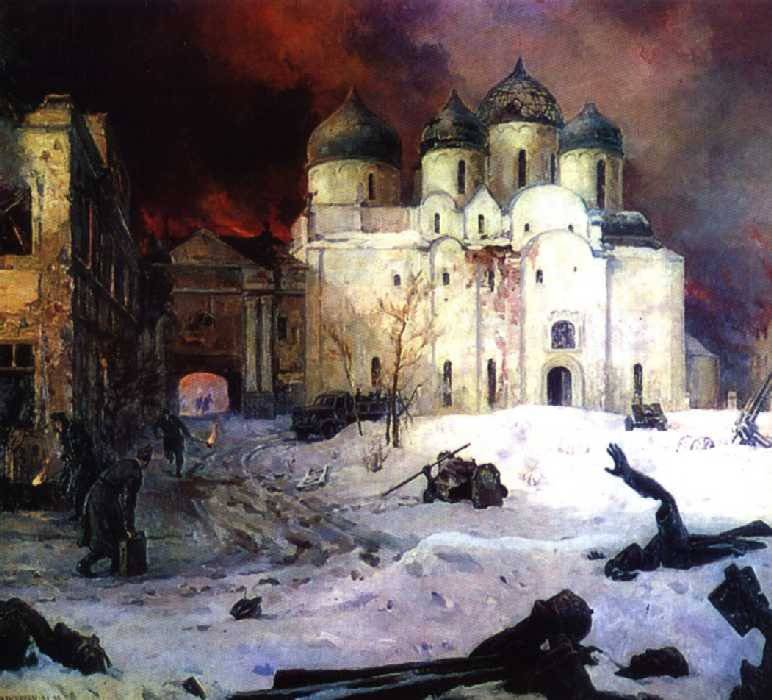
Painting "The Escape of the Nazis from Novgorod", Kukryniksy, 1944 — 1946.
Many unique sights and monuments were completely destroyed or badly damaged. From the Novgorod Museum, which did not have time to evacuate, the most valuable collections on the history of archeology and art were stolen. The destruction and losses were so great that they became an irreparable loss of part of the Russian national culture. St George's Cathedral, built at the beginning of the XII century, was badly damaged. St. Sophia Cathedral, built in the XI century and being one of the oldest monuments of Russian architecture, a treasure of Russian culture, which had frescoes and icons of the XII century, was destroyed. The interior of the cathedral was looted. The Church of the Annunciation on the arcade of the XII century, with frescoes of the same century, was turned into a pillbox and a barracks room. The church suffered greatly. The Church of the Assumption on Volotovy Field, a monument of the northern Russian architecture of the XIV-XV centuries, was turned into a pile of debris. The Church of the Transfiguration of the Savior on Ilyin Street, a monument of Novgorod architecture of the 14th century, also famous for its paintings made by the great master Feofan Grek, has suffered greatly. Most of the frescoes were destroyed and the remaining ones were damaged. The Church of the Savior Nereditsa - a monument of ancient Russian art of the XII century, famous for Byzantine and Russian painting, was barbarously destroyed. The Novgorod Kremlin, its towers and internal structures suffered greatly. By order of the commander of 18 of the German army, Colonel-General Lindemann, the Nazis dismantled and prepared for sending to the German Empire a monument to the 1000 anniversary of Russia. The monument was dismantled, many unique sculptural images of the most prominent Russian state, military, public and cultural figures were destroyed.
Soviet power paid special attention to the restoration of Veliky Novgorod. 1 November 1945, the city was included in the number of fifteen settlements that were subject to primary restoration. Particular attention was paid to the restoration and restoration of historical monuments. One of the first was the restoration of the monument “The Millennium of Russia”, erected in Veliky Novgorod in 1862, in honor of the millennium of Russian statehood. Already 5 November 1944, the second grand opening of the monument.
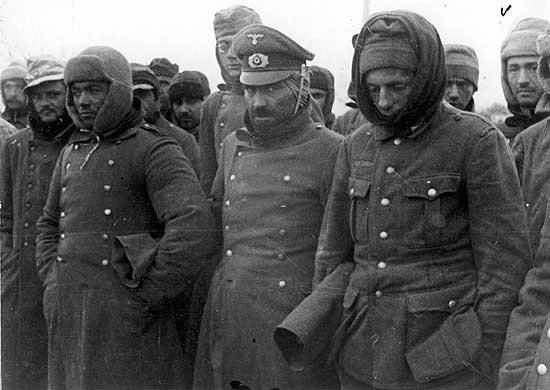
German prisoners on the streets of Leningrad
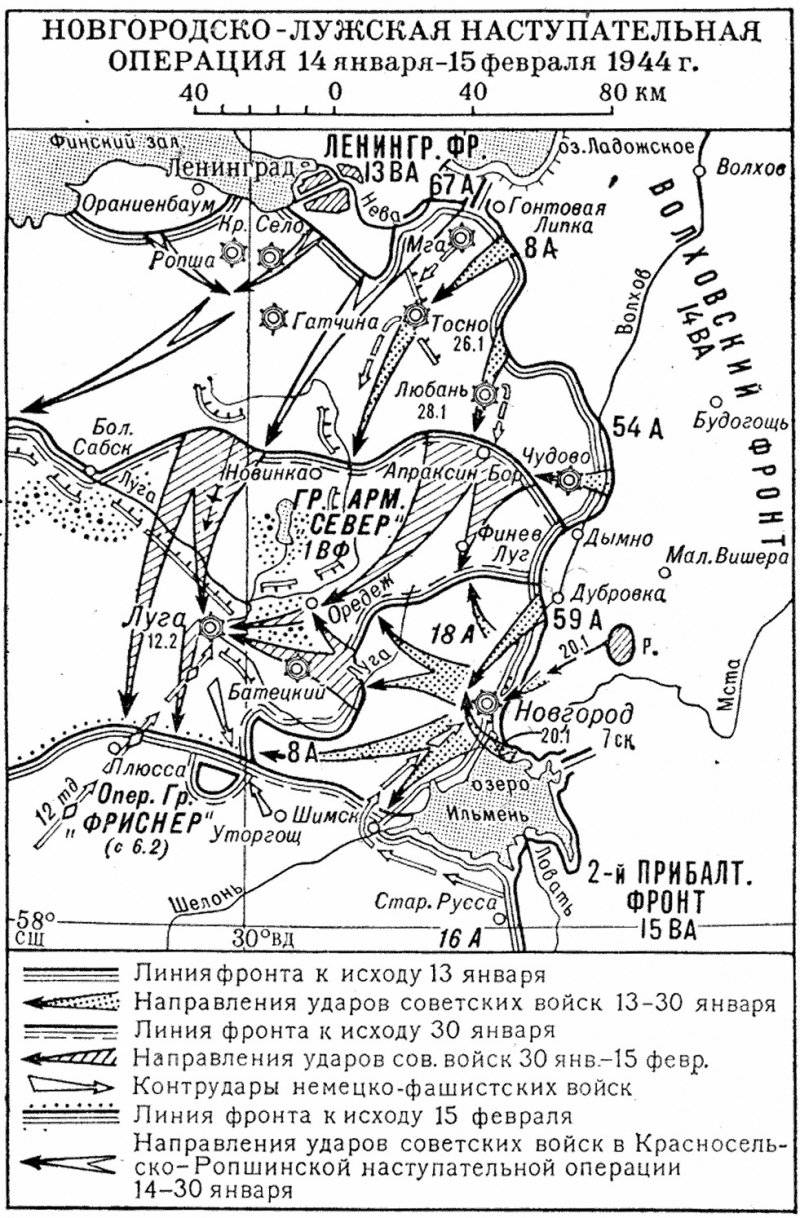
Information